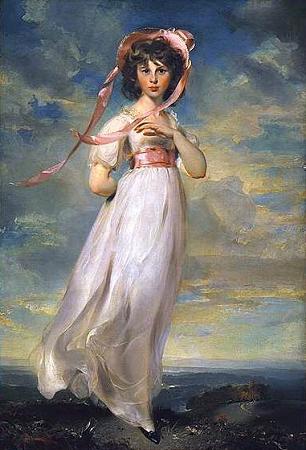Blue Boy (1770). Oil on canvas. 178 x 122. The Blue Boy is a full-length portrait in oil by Thomas Gainsborough, now in the Huntington Library, San Marino, California. Perhaps Gainsborough's most famous work, it is thought to be a portrait of Jonathan Buttle, the son of a wealthy hardware merchant, although this has never been proven. It is a historical costume study as well as a portrait: the youth in his seventeenth-century apparel is regarded as Gainsborough's homage to Anthony van Dyck, and in particular is very close to Van Dyck's portrait of Charles II as a boy. Gainsborough had already drawn something on the canvas before beginning The Blue Boy, which he painted over. The painting is about life-size, measuring 48 inches wide by 70 inches tall. Gainsborough painted the portrait in response to the advice of his rival Sir Joshua Reynolds, who had written: It ought, in my opinion, to be indispensably observed, that the masses of light in a picture be always of a warm, mellow colour, yellow, red, or a yellowish white, and that the blue, the grey, or the green colours be kept almost entirely out of these masses, and be used only to support or set off these warm colours; and for this purpose, a small proportion of cold colour will be sufficient. Let this conduct be reversed; let the light be cold, and the surrounding colour warm, as we often see in the works of the Roman and Florentine painters, and it will be out of the power of art, even in the hands of Rubens and Titian, to make a picture splendid and harmonious. The painting was in Jonathan Buttle's possession until he filed for bankruptcy in 1796. It was bought first by the politician John Nesbitt and then, in 1802, by the portrait painter John Hoppner. In about 1809, The Blue Boy entered the collection of the Earl Grosvenor and remained with his descendants until its sale by the second Duke of Westminster to the dealer Joseph Duveen in 1921. By then, it had become a great popular favourite in print reproductions, after being exhibited to the public in various exhibitions at the British Institution, Royal Academy, and elsewhere. In 1919, the painting inspired German film producer Friedrich Wilhelm Murnau to create his debut film Knabe in Blau. In a move that caused a public outcry in Britain, it was then sold to the American railway pioneer Henry Edwards Huntington for $728,800, according to Duveen's bill, a then-record price for any painting. According to a mention in The New York Times, dated 11 November 1921, the purchase price was $640,000, which would be $8.99 million in 2018. Before its departure to California in 1922, The Blue Boy was briefly put on display at the National Gallery where it was seen by 90,000 people; the Gallery's director Charles Holmes was moved to scrawl farewell words on the back of the painting: Au Revoir, C.H. It was this painting that moved pop artist Robert Rauschenberg toward painting. It is often paired with a painting by Thomas Lawrence called Pinkie which sits opposite to it at the Huntington Library.
more...







